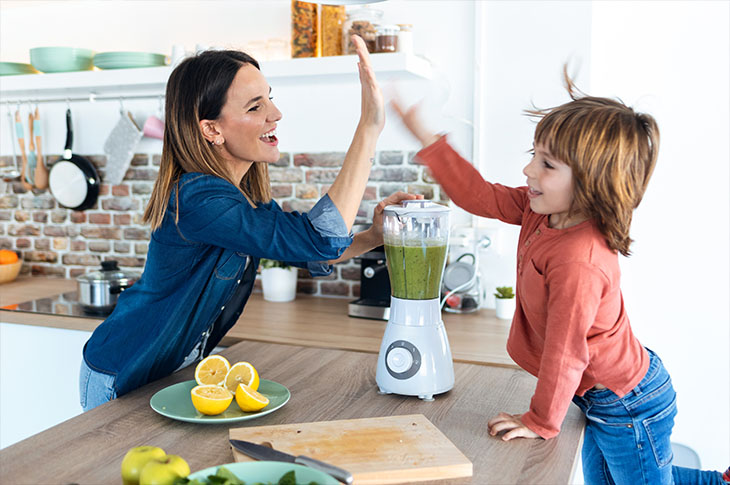
Back-to-school season is upon us, which means busy days of juggling homework, after school snacks, and trying to sneak in some quality family time. So why not combine a few of those things together with educational snack ideas that let your kids learn while fueling their bodies?
“There is so much for kids to learn about food, from where it comes from to how it impacts the environment and our bodies,” explains family dietitian Nicole Stefanow, MS, RDN. “Playing with food is an engaging and interactive way for kids to learn about science, math, history, and art.”
Regardless, if your child is a toddler or headed off to high school, taking learning into the kitchen can provide a variety of benefits. Here’s how top dietitian moms combine snacking and education in a fun way that provides both food exposures and critical thinking skills:
Spot the Difference Activity
Children of any age can enjoy this educational snack while fine-tuning their observation skills. The goal of this activity is to take similar foods, such as two varieties of pears, and compare and contrast them. “Considering how two items can be similar and different at the same time improves grayscale thinking versus black and white thinking,” explains Dani Lebovitz, MS, RDN, CSSD, CDCES, and creator of Kid Food Explorers.
To set up this educational snack activity, gather two types of crackers, pears, and cheeses. “Allow each child to make observations while placing the snack on a plate and taste testing,” shares Lebovitz.
She recommends asking children questions such as, “What is the same about these two pears?” and “What is the difference?” Have your child note similarities and differences using all of their senses including taste, smell, texture, and appearance. This activity is a perfect way to expose your child to a new food in a pressure-free way as well.
Smoothie Math
“Using math in everyday activities like cooking can help reinforce the lessons they are learning in the classroom,” shares Stefanow, who loves to use smoothies as a way to teach math principles while offering nutrition benefits at the same time. “Smoothies are a fun way to make sure picky eaters are getting the fruit and vegetable servings they need, while using a yogurt or milk base can provide added protein and calcium.”
To get started, set up your smoothie station with only a one quarter measuring cup instead of taking out all your measuring tools. Then have your child read the recipe instructions, helping as needed, and let them determine how many quarter measuring cups they need to fill with each ingredient. “Working with measuring cups during this activity can help introduce your child to fractions,” adds Stefanow. And for younger children who are not quite yet ready for fractions, you can incorporate math in other ways, such as by counting ingredients.
Decoding Patterns
What can be more fun than using some of your favorite foods to create edible patterns for your children to replicate and eat? “Creating and identifying patterns is an important early math skill. In addition, you can ‘debug’ patterns by finding an error and fixing it,” explains Lebovitz.
To set up this activity, Lebovitz suggests using berries, graham crackers, and nut butter (allergy-conscious options include sunflower butter or hummus). “Cover the graham cracker with a thin layer of nut butter and place the berries in a pattern on top of the graham cracker,” she adds. You can then ask your child to replicate the pattern on their own graham cracker canvas or ‘solve’ a pattern by filling in a missing section. You can even create a series of patterns, some correct and some with errors, and ask your child to debug the incorrect patterns.
Tangrams
If you want to challenge your school-aged child, try setting up an edible tangram. This puzzle, which is made up of seven shapes that can be arranged to form various designs, can be a great way to strengthen problem solving skills and teach spatial awareness. “Use firm raw fruits and vegetables like cucumbers, apples, carrots, and peppers and cut them into triangles, squares, and rhombus shapes. Then, let your child arrange the shapes to make fun pictures like houses, rockets, fish, airplanes, or birds,” shares Stefanow.
Not only can this activity help to build critical thinking skills, but it can also be an excellent way to increase your child’s exposure to a variety of fruits and vegetables.
The Leaning Tower of Vegetables
This STEM activity is perfect for little learners and older kids alike. Simply provide your child with edible ‘building materials’ and let them work at creating the tallest tower possible. To get started, gather a variety of firm vegetables cut into ‘sticks’, such as carrots and celery, along with an edible ‘glue’ which can be anything from nut butter to hummus or cream cheese.
Ask your child to build a tower that can stand on its own. As he builds, your child will be testing his engineering skills to determine what combination of building materials will achieve the best outcome. And after the tower has been created, you can dig in and enjoy the edible art.
The post Transform Snack Time into Learning Time appeared first on Fitbit Blog.
source https://blog.fitbit.com/transform-snack-time/
No comments:
Post a Comment